








EMI BATTAGLIA AND ANNETTE VAN DE KAMP-WRIGHT
Jewish Press Editor
In her first book, The Heirloomist: 100 Treasures and the Stories They Tell (Chronicle Books; April 30, 2024), photographer and Omaha native Shana Novak showcases a collection of keepsakes belonging to cultural icons and everyday folks alike, all carrying one common thread: the objects are treasured for deeply personal and often surprising reasons. Their corresponding stories range from romantic to wistful, from hilarious to powerfully affecting. Through Novak’s heartfelt writing style and gift with a camera, every belonging comes to life on the page as a unique work of art. Shana will be at The Bookworm on June 29 at 2 p.m. to do a book signing.
“An heirloom can be anything, as long as it tells your story,” she said. This she learned from her grandmother, who stored entire sets of fine sterling silverware right next to a metal plate implanted in her leg after she was run over by a golf cart in Palm Springs. It didn’t matter if an object was precious or priceless—the value was always
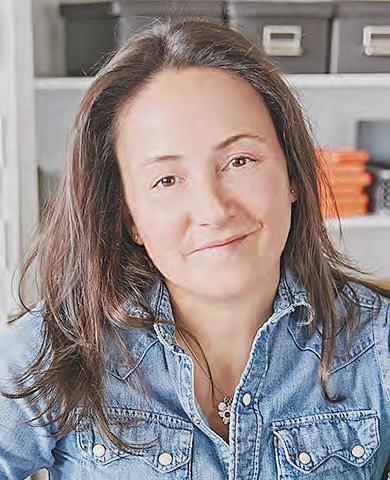
in the memory it held. This lesson, and the death of her grandmother, inspired The Heirloomist, a photography project designed to visually preserve and artfully celebrate our belongings and the stories they hold. Within a year of its founding, Gwyneth Paltrow’s goop gift guide listed The Heirloomist as the season’s hot new personalized gift. To date, The Heirloomist has worked with nearly 1500 clients from across the country.
That client list includes our own Nebraska Jewish Historical Society: in 2013, her photos of classic Jewish Omaha objects were auctioned off for the NJHS’ fundraiser.
Shana is the daughter of Jerry Novak and Linda Novak, and the granddaughter of the late Rose and Max Novak of Omaha and the late Gene and Phyllis Neuswanger of San Diego, CA. Long before she became a celebrated photographer and writer, she wrote for the Jewish Press:
“At some point in high school,” she said, “I must have brazenly walked myself into Morris Maline’s office at the Press asking for a job. He was the Editor in Chief at the time, and he didn’t have to give the kid standing in front of him anything—but he See The Heirloomist page 3
STACIE METZ
JFO Foundation Program and Stewardship Administrator
We are thrilled to introduce our Young Professional Tzedek Program (YPTP), dedicated to empowering
young adults to make a lasting impact through charitable giving. This type of account, administered by The Jewish Federation of Omaha Foundation, is utilized like a charitable checking account.
YPTP serves as a bridge program for young adults who previously held a teen fund account, currently main-
tain one, or are interested in opening an account and are between the ages of 18 and 35.
The Young Professional Tzedek fund holders will enjoy the following benefits:
• Flexibility to allocate contributions at any time, with a minimum allocation required once a year to keep funds active.
• Support for multiple charities through a single fund.
• Seamless transition from a Teen Fund to a Young Professional Fund.
• No administrative fees.
YPTP fund holders will have the opportunity to choose a non-profit organization that holds personal significance. Upon selection, the nonprofit will be notified of an upcoming grant (donation). Recommendations for grants can be dispersed as frequently as desired, provided that each grant meets the following criteria:
• Minimum of $18 per donation.
See A (giving) bridge page 3

The Omaha Young Professionals (OYP) community gathered for an extraordinary Shabbat dinner, blending tradition with camaraderie in an evening that will be remembered by all attendees. The beautifully set tables with china dishes and the promise of a fourcourse traditional Shabbat dinner
created an ambiance of elegance and warmth.
The evening commenced with a short cocktail hour, where one of the participants showcased their bartending skills, mixing both alcoholic and non-alcoholic options to suit everyone’s preferences. This casual mingling set the stage for the
See OYP Shabbat Dinner page 2



SHIRLY BANNER
JFO Library Specialist
On June 20 at 1 p.m. the Dorothy Kaplan Book Discussion Group will gather for their monthly meeting. Group members have the choice of meeting either in person in the Benjamin & Anna Wiesman Reception Room in the Staenberg Jewish Community Center or via Zoom. This month they will be discussing The Yid by Paul Goldberg. New participants are always welcome.
The Yid is an historical fiction novel set in Moscow of 1953 where Stalin’s pogrom to “forever rid the Motherland of the vermin [Jews]” is taking place. Government agents called Black Maria come in vehicles to arrest Jews, much like the Gestapo of WWII who came to collect Jews to “relocate” them into ghettos and concentration camps. In Goldberg’s novel, an actor from the defunct State Jewish Theater named Solomon Shimonovich Levinson is the intended arrestee. Levinson manages to kill the government agents which sets in motion a crazy madcap adventure to assassinate Stalin - with the help of several of his friends that he picks up along the way. A Yiddish-speaking African-American engineer from Omaha named Friederich Lewis is enlisted as Levinson’s driver, a former surgeon named Aleksandr Kogan who has



Continued from page 1 more formal aspects of the evening.
As the sun set, the women and girls lit the Shabbat candles, reciting prayers for peace and well-being for their brothers and sisters in Israel. This poignant moment filled the room with a sense of unity and purpose, grounding the evening in a shared spiritual experience.
Participants then enjoyed a beautiful Kiddush service, followed by the delicious homemade challah. The rich traditions of Shabbat were brought to life, fostering a deep sense of community and connection among the guests.
The dinner featured a delightful four-course meal, beginning with traditional gefilte fish and matzo ball soup. Each dish was a nod to time-honored recipes, lovingly prepared to reflect the rich culinary heritage of Jewish cuisine. The table buzzed with conversation and laughter, as old friends caught up and new connections were made.
A highlight of the evening was the inspiring words from Chabad’s spiritual leader, Rabbi Katzman, who spoke about the importance of community and tradition in modern life. As a special treat, Rabbi Telushkin, in town for Tapestry Week, made a surprise appearance. He shared thoughts on the Rebbe and his groundbreaking approach to positivity, leaving the guests deeply moved and inspired.
been awaiting his own Black Maria pickup, and Kima Petrova who is seeking her own path of vengeance in Mother Russia. Peppered with a blend of history and fantasy, Goldberg’s characters are inspired by the likes of the renowned Yiddish actor Solomon Mikhoels, Marc Chagall, and American actor Paul Robeson. As Levinson’s small band of characters leaves behind a path of brutality and morbid deaths, one can only wonder how they can possibly be so violent yet so passionate in their discussions of Russian history, Marxist- Leninism, racism, Shakespearean theatre, and Judaism. Goldberg’s debut novel at times gets a heavy dosage of philosophy with farce, but ultimately portrays the anti-Semitic sentiments that still existed after WWII and Hitler’s failure of a “Final Solution.”
Please feel free to join us on June 20 in person or via Zoom. The Dorothy Kaplan Book Discussion Group meets on the third Thursday of every month at 1 p.m. New members are always welcome.
The Group receives administrative support from the Community Engagement & Education arm of the Jewish Federation of Omaha. For information about the group and to join in the discussion, contact Shirly Banner at 402.334.6462 or sbanner@jewish omaha.org



The success of this Shabbat dinner has set the stage for future events, with OYP participants excited to make the Shabbat dinner a monthly cornerstone. The evening not only celebrated Jewish traditions but also strengthened the bonds within the community, promising many more nights of unity, tradition, and inspiration.
In the words of one attendee, “This Shabbat dinner was more than just a meal; it was a celebration of our heritage and a reaffirmation of our commitment to each other and our community. I can’t wait for the next one.”
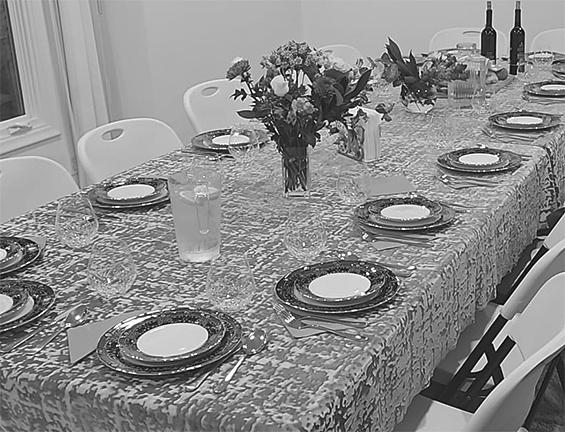

JTA
Four more male hostages held in Gaza since Oct. 7 are believed to be dead, according to an announcement by the Israeli army.
The army on Monday named the hostages as Chaim Peri, Yoram Metzger, Amiram Cooper and Nadav Popplewell and said that Hamas was holding their bodies. The army also announced on Monday that a man who had been thought to be a hostage, Dolev Yehud, had in fact been killed on Oct. 7.
The revelations mean that more than a third of the 120 hostages thought to remain in Gaza are known to be dead.
The army said it was able to determine that the four men had died despite not being able to retrieve their bodies.
“The decision to pronounce the four hostages dead was based on intelligence and was confirmed by a Ministry of Health expert committee, in coordination with the Ministry of Religious Services and the Chief Rabbi of Israel,” it said in an announcement.
“The circumstances of their death in Hamas captivity are still under examination by all the relevant professionals.”
The four men who had been taken alive to Gaza had appeared in hostage videos, although Hamas said when it released a video of Popplewell in May that he had been killed in an Israeli airstrike since it was filmed.
Israeli officials said they believed the four men had died several months ago in Khan Younis while the army was operating there. Several other hostages have been killed during failed rescue operations, while the causes of death for some found died in Gaza remain unknown.
“I know that difficult questions will arise regarding the circumstances of the deaths,” Daniel Hagari, an IDF spokesman, said during a press conference. “We are examining the circumstances of death in depth, looking into all possibilities, and we will present the findings as soon as possible.”
The Hostages Family Forum, which represents the families who have joined in
Continued from page 1
• Designated to a 501(c)(3) organization or charitable organization.
• Fund maintains a minimum balance of $100.
What happens next?
For current Tzedek Teen, Young Jewish Giving or B’nai Tzedek Teen account holders who are at least 18 years old, we will transfer your fund to a YPTP account. If the YPTP fund reaches $2500 by or before the fund holder’s age of 35, it will transition into a Donor-Advised Fund at The Foundation.
protests urging the government of Israeli prime Minister Benjamin Netanyahu to reach a ceasefire deal with Hamas, said the news of their deaths “should shake every citizen in the State of Israel and lead every leader to profound soul-searching.”
It called on the Israeli government to approve a deal that U.S. President Joe Biden said last week was an initiative of Netanyahu’s, and which would establish a temporary ceasefire and release elderly, wounded and child hostages immediately in exchange for hundreds of Palestinians detained by Israel.
“The Israeli government must send out a negotiating delegation this evening and return all 124 hostages, both living and murdered, to their homes,” its statement said. “It is time to end this cycle of sacrifice and neglect. Their murder in captivity is a mark of disgrace and a sad reflection on the significance of delaying previous deals. We reiterate our demand to the Israeli government: approve the Netanyahu deal immediately!”
Netanyahu has not publicly acknowledged ownership of the deal, although Israeli officials have told Israeli media that parts of it comport to a version his government submitted weeks ago, while saying there remain significant gaps. Far-right parties have threatened to bolt the coalition if he agrees to the deal, which requires Israel to pull out of major population centers in Gaza.
Cooper, 84, Metzger, 80, and Peri, 80, were all from Kibbutz Nir Oz, and Popplewell, a dual British-Israeli citizen, was from Kibbutz Nirim. Both kibbutzes suffered heavy losses on Oct. 7 when Hamas terrorists killed over 1,200 people and abducted more than 250, launching the current war. Popplewell’s mother, Channa Peri, was released during a temporary ceasefire in November, as was Cooper’s wife, Nurit, and Metzger’s wife, Tamar.
On Oct. 7, Peri hid his wife in the safe room and went out to fight the invading terrorists, deflecting attention from his wife, who was not harmed; the family later learned from a Nir Oz woman who was released that he had been abducted alive.
Continued from page 1 gave me an internship. That gesture opened the world of journalism for me. I also now know that it wasn’t all about me— I believe Morris understood the importance of giving younger generations a voice in the paper.”
His plan worked, she said: “In 1995, under the guidance of Mike Platt, who was the Pacesetter Chairman of the Federation at the time, and Joanie Jacobson, who took me under her writer’s wing, we founded the Teen Age page. This was a weekly feature dedicated to news of young community members doing extraordinary things.”


The moral of the story: “My internship with the Press was an early example of a kid being seen and supported,” Shana said, “and being given a chance. That is such a beautiful and integral thing for a community. I am ever grateful Omaha provided me that.”
The book includes photos of her father, Jerry Novak. “He owned a horse for a time,” she said, “and fancied himself a cowboy so we featured his cowboy hat and talked about
how it symbolizes his penchant for adventure. My mother, Linda Novak, has her charm necklace featured. This was a fun one, because her charms are fastened in chronological order so you can track all the things in her life that led her to Omaha.”
The Heirloomist is a stylish addition to any coffee table for anyone interested in a modern take on heirlooms and a meaningful gift for Mother’s Day, Father’s Day, graduation, or any occasion. And yes, several familiar Omaha faces are included.
“It’s a glorious reminder that this planet we spin around on is full of wonder, joy, heartbreak, love, and most of all, connection,” she added.
Shana Novak draws her spirited storytelling abilities from an early career in fashion and advertising. She has been working as a still life photographer in New York City for more than 10 years and has collaborated with brands such as Coca Cola and Procter & Gamble. Her work has been featured in Architectural Digest, O, The Oprah Magazine, Rolling Stone, and goop, among others, on CBS Mornings, and in The Fuller Museum. She writes a monthly column, Everyday Heirlooms, for Country Living magazine.
If, at age 35, the fund holder’s balance is less than $2500, fund holders may add to the balance to open a Donor-Advised Fund, or the funds will be pooled to create matching donations for opening new Tzedek Teen accounts. We are enthusiastic about this opportunity and honored to continue to support you in your philanthropic endeavors. If you are interested, and do not currently have a fund at The Foundation, we look forward to speaking with you. Reach out to Stacie Metz at 402.334.6485 or smetz@jewishomaha.org with any questions and to open your account.




The below recipe is reprinted from What’s Cooking? The recipe collection presented by friends and family on the occasion of Shirley Goldstein’s 80th birthday.
“As we celebrate your 80th birthday,” the introduction reads, “we salute you for the wonderful life you have lived. You have been a loving, guiding, compassionate force in our lives and we are blessed to be touched by you.”
You can find other recipes from Shirley’s cookbook at our website at www.omahajewishpress.com
Ingredients:
1 pound beef liver (or chicken or calves)
1 large onion
2 Tbsp. chicken fat (I found schmaltz in the freezer section of our local kosher deli)
3 hard boiled eggs
Directions:
Wash liver and slice onion.
Brown liver and onion briefly in 1 Tbsp. chicken fat.
Place 1 Tbsp. chicken fat in bottom of baking pan, add onion slices, and cover with liver. Add a little water. Bake at 450 degrees for 15-20 minutes; turn liver during baking.
Allow it to cool in refrigerator.
Then grind/chop liver and onion in Cuisinart or grinder, and add salt to taste. Add two sliced hard boiled eggs.
Put in small tube pan or serving dish, then top with other chopped hard boiled egg.
Serves 6-8.
Recipe from: Janie Kennedy with help from Gail Raznick
Originally from: Ma (Selma) Gershun
Usually served when trying to submit a recipe that is really related to Shirley Goldstein, and craving some good chopped liver. Ma (and later Shirley) would serve it on Friday nights or when company was coming.
Eat on crackers (or celery if you are dieting); there are no calories in this! Gail gave hints from her notes from Ma and other recipe books. She says it really tastes like Ma’s chopped liver!

PARSHA NASO
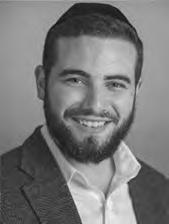
Usually, I like to start with a story or some (corny) rabbi humor. However, there is a powerful lesson in this week’s parsha, and I feel the need to cut straight to the chase. I want you to take a moment and think about your life. Think about the things that you are most proud of. Now, think about whether you have any regrets. According to NIH (National Institute of Health) within the top ten for most people are family and friends. You rarely find a person who looks back at their life and wishes they had spent more time at the office and less with their loved ones. So why is this such a common phenomenon? Why do we spend so much time on our careers and other goals?
In this week’s parsha, the Mishkan (temporary Temple) is complete, and the first offerings have been brought. What is fascinating is that the princes of each of the Jewish tribes each get a day to bring their own offerings. Yet, not only did they each bring the exact same thing, the Torah lists each day’s offerings. Since they each brought the same thing, the Torah could have written it once and then said they all brought the same thing. Instead, it taught us a valuable lesson. Technically, they each brought the same offerings, but in truth, they were totally different. Because the person bringing the offering was totally unique from anyone else. And that’s what made the offering precious to G-d. Rabbi Dr. Abraham Twerski explains the reason why I spend too much time in the office. It’s because I tell myself that the best thing I can give my family is more money. I missed the lesson of the Princes. The most precious thing one can give is something that no one else can. Time in your company.
Shalom.

After weeks of campus protests at the University of Copenhagen, hundreds of students won their demand: a halt to the school’s investment in companies that operate in the Israelioccupied West Bank.
The university said on May 28 that it will divest its holdings worth 1 million Danish Krone, about $145,500, in Airbnb, Booking.com and eDreams, which appear on a U.N. list of businesses with activities in the West Bank. The University of Copenhagen has a yearly revenue of over 10 billion Danish Krone, or $1.5 billion.
It’s the latest in a crop of universities across Europe — including schools in Spain, Ireland, Norway, the Netherlands, Belgium and the United Kingdom — that have agreed to divest from Israel-linked companies or boycott Israeli institutions.
The policy changes ride a wave of student protests against Israel’s eight-month war in Gaza, a military response to Hamas’ Oct. 7 attack on Israel that has killed over 36,000 Palestinians and inflamed global opinion.
ken out against Israel appear to be more likely to meet student demands,” said Whitten. “One reason for this may be that they are less worried about sanction or scrutiny from the government. Another might be that there will be less backlash from the surrounding public in that country.”
Protesters have not been as successful in Germany and France, whose governments align more closely with Israel. Universities in Berlin and Paris have called in police to end student demonstrations. German leaders in particular have argued they hold a special responsibility toward Israel, calling Israel a “reason of state” for Germany because of its history of the Holocaust.
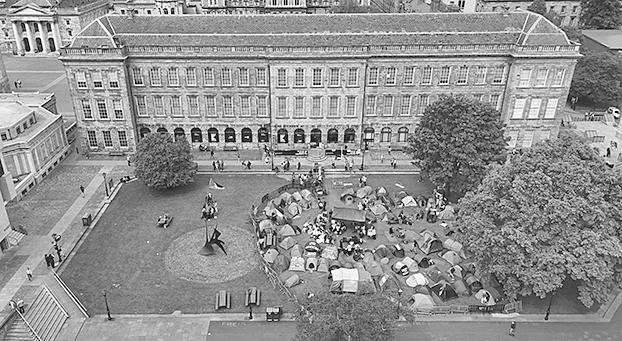
Europe’s student activists took inspiration from the United States, where a spate of pro-Palestinian demonstrations and encampments roiled campuses this spring. But compared with U.S. students, protesters in Europe have won more concessions from their universities.
That’s partly because European universities face less of the legal, political and cultural pressure on U.S. universities, according to Suzanne Whitten, a political theory lecturer at Queen’s University Belfast. U.S. politicians have called university leaders to account in Congress for their handling of protests, leading to the ousting of some. Thirty-eight states have laws that discourage boycotts of Israel. And U.S. universities rely more on private donors than universities in Europe, including some who say they are withdrawing gifts to their alma maters over the protests.
“The market-driven higher education system in the U.S. has produced a climate where universities face immense scrutiny from donors, politicians and students as paying customers,” Whitten told the Jewish Telegraphic Agency. “The U.S. is also highly litigious, takes equality policy and legislation very seriously, and has a very strong relationship politically with Israel that just isn’t there in the same way with European institutions.”
The U.S. movement has been marked by crackdowns from university administrators and police at dozens of campuses, including evictions, suspensions and more than 2,900 arrests nationwide. A few schools have allowed students to continue protesting or even agreed to negotiate with them. At universities including Brown, Harvard, Northwestern and Rutgers, administrators have cut deals to disclose investments or review students’ proposals in exchange for ending their encampments.
But no university in the United States has said it will sever ties with Israel, and many have explicitly said they will not divest. At Sonoma State University, President Ming-Tung “Mike” Lee announced a decision to pursue divestment and an academic boycott of Israeli universities. He was suspended for “insubordination” within 24 hours and retired the next day. Meanwhile, a growing number of European universities have met the demands of student protesters.
Ireland’s Trinity College Dublin also acquiesced to student protesters on May 8 after an encampment blocked entrance to the Book of Kells, a medieval manuscript and major attraction for paying tourists. The school said it would divest from the one Israeli company on its supplier list.
Spain has seen a particularly strong embrace of the student movement. The Conference of Rectors of Spanish Universities, or CRUE — representing 76 private and public universities — promised on May 9 to review agreements with Israeli academic institutions and suspend collaboration with any that “have not expressed a firm commitment to peace and compliance with international humanitarian law.” Since then, universities in Granada, Oviedo and Barcelona have cut ties.
In Norway, five universities suspended their ties with Israeli universities as early as February.
It’s no coincidence that some of the schools fastest to issue boycotts and divestment are in Belgium, Spain, Ireland and Norway, Whitten said. The governments of those countries are among Israel’s most vocal critics in Europe, with the latter three formally recognizing a Palestinian state on May 28 following a campaign by Spain’s president.
“In general, those countries where governments have spo-
Still, student movements have continued to achieve policy shifts in other parts of Europe. Last week, the Université Libre de Bruxelles joined three other Belgian universities that have ended or committed to review ties with Israeli institutions. The ULB said it was suspending ties with both Israeli and Palestinian universities until their respective authorities committed to the demands of the International Court of Justice and until the unconditional release of Israeli hostages.
And although the Netherlands saw clashes between protesters and riot police at the University of Amsterdam, the Royal Academy of Art in The Hague became the country’s first university to institute an academic boycott by severing its relationship with the Israeli Bezalel Academy of Arts and Design.
In the United Kingdom, Goldsmiths University of London agreed to student demands that included reviewing its investment policy, expanding scholarships for Palestinian students and renaming a building after Palestinian journalist Shireen Abu Akleh. (A handful of U.S. schools have agreed to similar demands.) The University of York said it would divest from arms manufacturers.
Many European Jewish students oppose divestment and boycott measures, said Emma Hallali, president of the European Union of Jewish Students, which represents 160,000 Jews across 36 European countries. While these Jewish students embody a range of political opinions and views on Israel, Hallali said she hears a pervasive sentiment that their universities have responded to protesters’ demands without addressing a rise in campus antisemitism. An EUJS report in February found 110 antisemitic incidents at European universities since Oct. 7, with 32% tied to in-person harassment and physical violence.
In both Europe and the United States, some protests have featured threatening behavior targeted at Jewish students, though it is not always clear if the actors are classmates or non-student protesters. But Jews are a larger minority at many U.S. campuses, comprising more than 20% of the student body at Columbia, Cornell and Brown, and some Jewish students count among the protesters at U.S. universities — such as those represented by the anti-Zionist group Jewish Voice for Peace. In Europe, home to less than 10% of the world’s Jews, Jewish students are almost always isolated on their campuses.
“The diversity, equality and inclusion offices of universities are supposed to be protective of their Jewish students, like any minority,” Hallali told JTA. “Jewish students are always less than 10% of the universities in Europe. [Diversity] offices and universities are just not protecting them, so those students are fearing to go to school, they are fearing for their safety.”
Another hurdle faces student activists in the United States, according to Robert Cohen, who studies higher education and social protest at New York University: Their movement is unpopular — and not just because of U.S. views on the IsraeliPalestinian conflict.
“Student movements in the United States are never popular, it doesn’t matter the issue,” he said. “Even as the country eventually, by 1968, started turning against the Vietnam War — the war was unpopular, but the anti-war movement was even more unpopular than the war.”
B’NAI B’RITH BREADBREAKERS
The award-winning B’NAI B’RITH BREADBREAKERS speaker program currently meets Wednesdays via Zoom from noon to 1 p.m. Please watch our email for specific information concerning its thought-provoking, informative list of speakers. To be placed on the email list, contact Breadbreakers chair at gary.javitch@gmail.com












There’s two political Mongolias: Inner Mongolia is a northern province of China, and Outer Mongolia, an independent country between Russia and China. Fran and I went to visit both on two different trips. Long ago, the Mongols were feared as nasty warriors on horseback and conquered much of Asia. Just think of Genghis Khan and his grandson Kublai Khan, 13th century rulers who created the largest empire on earth.
This tour was the entirety of China: Suzhou, Beijing, Xian, Shanghai, in addition to Inner Mongolia. While boarding the train in Beijing, we saw lots of Han Chinese citizens wearing very similar blue outfits. They were going to Hohut, the capital of the province of Inner Mongolia...permanently. The government was shipping the “regular” Chinese to Inner Mongolia as permanent residents to make them the majority in the city. The Han Chinese weren’t happy about it either, but this was 1978 (similar to what happened later to Tibet).
Among our group was Dr. Irving Cohen. He suggested:


“Why don’t we visit a hospital in Hohut?” and so that’s what we did. We wandered through the hospital with the guide. Some of the patients were nearly naked, but we barged into their rooms. It didn’t seem to bother them.
“What type of medicine do these patients get?” asked Dr. Cohen.
A hospital administrator explained: “The patients get whatever type of treatment they desire. We offer them a choice of Mongolian remedies (the whole root or leaf), the Chinese medicine (the traditional root or leaves is powdered and served in tea), or the Western medication (pills or modern treatment). Most of the patients want to do Western medicine.” Asked and answered.
Next day we journeyed by an old bus to the highlight of our trip: a two-night stay in a yurt. Also called a ger, these Mongol semi-permanent circular tents were located in the Gobi Desert. The yurts were designed to have a big family, but there were now only four cots in each of them. The restroom was down at the end of the line of yurts. We got to share a ger with a father, Peter, and his 16-year-old son, Jason. The teenage son was already an actor with some minor credits on TV and movies. That evening, after a very good dinner, Jason disappeared. The father, Peter, didn’t act surprised:
“It happens all the time. Now it’s time for bed. The lights are going out (and they did).”
Jason stayed out all night but reappeared early in the morning in time for breakfast. He never explained what he did overnight. It dropped 50 degrees at night so we used all the blankets. Jason stayed in the second night. During the day we were occupied with talks about how the Mongols were excellent horsemen and warriors, and that’s how they conquered China and most of the rest of Asia.
We left Inner Mongolia feeling exhilarated about staying two nights in the yurt; but we couldn’t help feel badly for the Han Chinese forced to live in another home, and the Mongolians who would lose their majority in their homeland.
As part of the Soviet Union tour, we visited Outer Mongolia. Technically, not part of the Soviet Union, it was an independent country in 1980, but under Moscow’s sphere of influence; and Mongolia did whatever the Russian masters said.
We flew to the capital, Ulan Batar (or Urga, or Ulaanbataar, depending on what the Mongols or you choose) in an Aeroflot propeller airplane (the airline used to be called “Aeroflop” for good reasons). We toured Ulan Batar, filled with Soviet-gray concrete buildings, and stayed in a hotel for two nights.
Our guide was Mongol. She said “call me Olga”, in her accented voice, but that wasn’t her real Mongol name. We didn’t learn much about Ulan Bator because Olga was sleeping on the bus most of the time. Reason: she was up all the night for “muffki-puffki” (to bring you another language) with her boyfriend in the Mongol army.
The bus was an ancient Soviet Army transport, but it ran. One day the bus took us out into the rural grasslands. We spotted a solo home, and signed to the bus driver that he should stop. Olga was sleeping for a change, and before she could say Nyet, we exited the bus and met with the wife of the house on the steppes. She pointed in the direction of the door, and so the group followed her to the Mongol sod and wood house (followed by Olga’s exclamations of Nyet, which we ignored).
The wife held the wooden door open and indicated that we should enter. So we did, and three of us sat in the old wooden chairs, and six of us sat on the dirt, unpaved floor. She poured us a cup, (made of horsehair), of mare’s milk, which is called kumis.
The cup had two floating horse hairs in it. She also passed around a plate of fermented mare’s milk cheese (also called kumis) to try. The wife was the apex of Mongol graciousness, and I didn’t want to insult her. So I pretended to sip the kumis, and stuck the cheese in a pocket in my jacket. The jacket smelled of kumis for days.
Next day we flew out in an old, small Russian propeller plane to the Gobi Desert. The airplane had no seat belts and no fixed backs on seats, so as we leaned back we found ourselves on the knees of the person who was sitting behind us. Obviously, we sat up straight; that was difficult during takeoff. The plane had 44 passengers and only 40 seats, so the last 4 passengers sat in back with the luggage. The airplane had a staff of 3: the pilot, the co-pilot, and the navigator. Finding the yurt camp from the air was the difficult job of the navigator.
The morning when we landed, it was again on the vast Gobi Desert. This was a deluxe yurt camp: every tent had an ensuite bathroom (instead of sharing the toilet with the other guests like in Inner Mongolia). The next morning our group headed in a rickety bus a long way toward the only river. It was spring, so when we went down to the river, surprise: we found big ice chunks in the shady, secluded nooks. I and another American young man, Chris, carried some ice back on the bus to the yurt camp. There was another group of German tourists that couldn’t figure out where we got the ice. They were complaining to their guide. We were silent.
Chris was a travel agent in Minneapolis and had brought several guests with him on the tour. There was only one gazebo in the camp and it had a large chess set in it. Chris and I played several games of chess. We were about even. After three days of the yurt camp, the old prop plane landed on the hard sand of the desert. We were ready to go. But the navigator of the plane indicated he wanted to play chess, so he pointed to the windsocks (who were not flapping in the wind). Chris joined the navigator at the gazebo chess set. Unfortunately, Chris won the first game, and the navigator’s Mongolian pride was hurt. So they played a second game. I never asked Chris if he “threw” the game, but the navigator won.
We boarded the plane with the seats that had no firm seat backs and no seat belts. At least they had less than 40 passengers so everybody had a chair. After 45 minutes we were back in Ulan Batar, the capital of Outer Mongolia.
I threw out the kumis-smelling jacket, and it was goodbye to Mongolia and the Mongols.
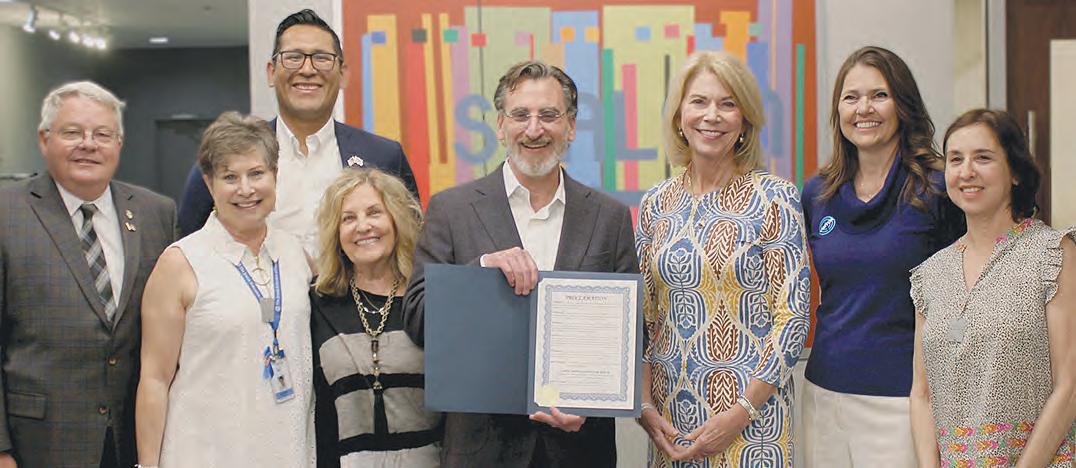



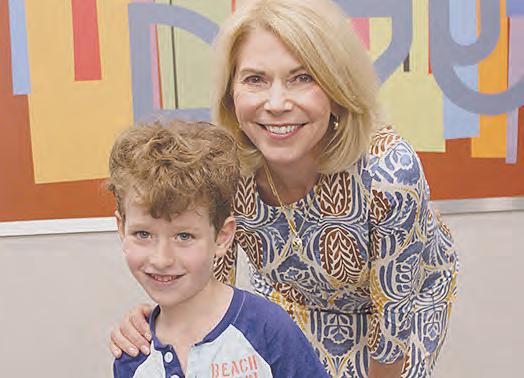

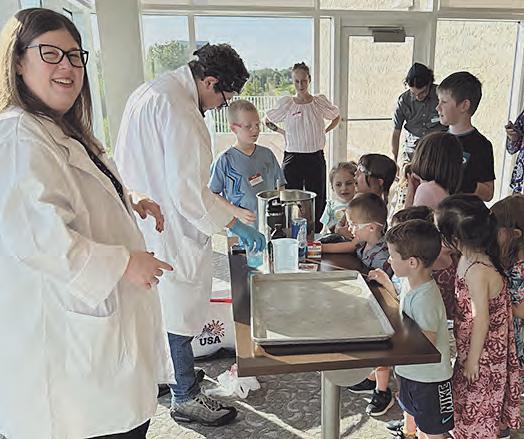
SUBMIT A PHOTO: Have a photo of a recent Jewish Community event you would like to submit? Email the image and a suggested caption to: avandekamp@jewishomaha.org
Below: Friedel’s third through sixth graders have been working on their Engineering Carnival over the last few weeks. Students worked to create a game that included at least one of our learning topics from the course of the year (balance, engineering builds, reflection/refraction, force and motion, and surface tension). They used the engineering design process and practiced problem-solving skills to create these games. Kindergarten through second graders got to use the finished games to practice their own problem-solving, collaboration, and communication abilities.





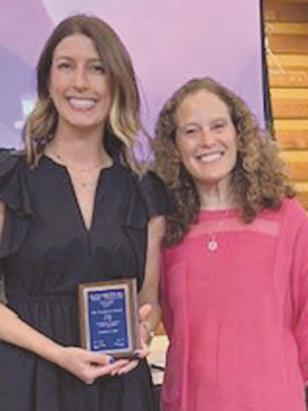
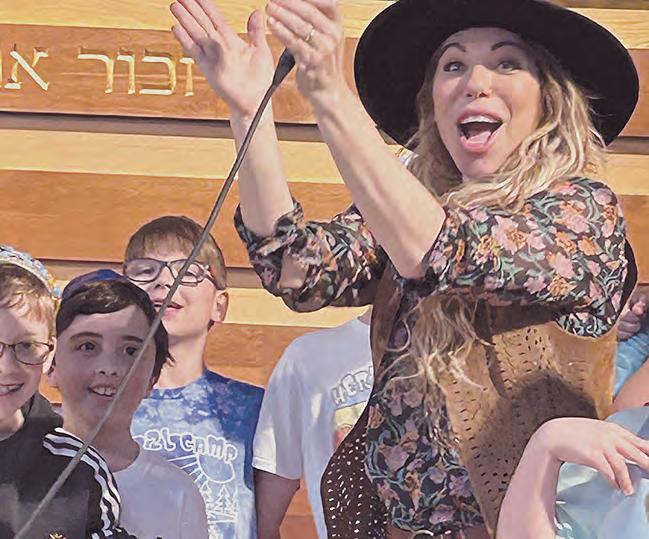

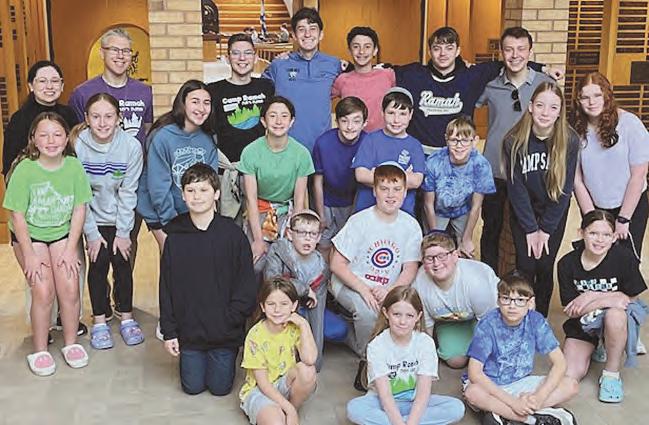
(Founded in 1920)
Margie Gutnik
President
Annette van de Kamp-Wright
Editor
Richard Busse
Creative Director
Howard Kutler
Advertising Executive
Lori Kooper-Schwarz
Assistant Editor
Gabby Blair
Staff Writer
Sam Kricsfeld
Digital support
Mary Bachteler
Accounting
Jewish Press Board
Margie Gutnik, President; Abigail Kutler, Ex-Officio; Helen Epstein; Andrea Erlich; Seth Feldman; David Finkelstein; Ally Freeman; Mary Sue Grossman; Chuck Lucoff; Suzy Sheldon; Joseph Pinson and Larry Ring.
The mission of the Jewish Federation of Omaha is to build and sustain a strong and vibrant Omaha Jewish Community and to support Jews in Israel and around the world. Agencies of the JFO are: Institute for Holocaust Education, Jewish Community Relations Council, Jewish Community Center, Jewish Social Services, Nebraska Jewish Historical Society and the Jewish Press Guidelines and highlights of the Jewish Press, including front page stories and announcements, can be found online at: www.jewishomaha.org; click on ‘Jewish Press.’ Editorials express the view of the writer and are not necessarily representative of the views of the Jewish Press Board of Directors, the Jewish Federation of Omaha Board of Directors, or the Omaha Jewish community as a whole. The Jewish Press reserves the right to edit signed letters and articles for space and content. The Jewish Press is not responsible for the Kashrut of any product or establishment.
Editorial
The Jewish Press is an agency of the Jewish Federation of Omaha. Deadline for copy, ads and photos is: Thursday, 9 a.m., eight days prior to publication. E-mail editorial material and photos to: avandekamp@jewishomaha.org ; send ads (in TIF or PDF format) to: rbusse@jewishomaha.org
Letters to the Editor Guidelines
The Jewish Press welcomes Letters to the Editor. They may be sent via regular mail to: The Jewish Press, 333 So. 132 St., Omaha, NE 68154; via fax: 1.402.334.5422 or via e-mail to the Editor at: avandekamp@jewishomaha.org.
Letters should be no longer than 250 words and must be single-spaced typed, not hand-written. Published letters should be confined to opinions and comments on articles or events. News items should not be submitted and printed as a “Letter to the Editor.”
The Editor may edit letters for content and space restrictions. Letters may be published without giving an opposing view. Information shall be verified before printing. All letters must be signed by the writer. The Jewish Press will not publish letters that appear to be part of an organized campaign, nor letters copied from the Internet. No letters should be published from candidates running for office, but others may write on their behalf.
Letters of thanks should be confined to commending an institution for a program, project or event, rather than personally thanking paid staff, unless the writer chooses to turn the “Letter to the Editor” into a paid personal ad or a news article about the event, project or program which the professional staff supervised. For information, contact Annette van de Kamp-Wright, Jewish Press Editor, 402.334.6450.
Postal
The Jewish Press (USPS 275620) is published weekly (except for the first week of January and July) on Friday for $40 per calendar year U.S.; $80 foreign, by the Jewish Federation of Omaha. Phone: 402.334.6448; FAX: 402.334.5422.
Periodical postage paid at Omaha, NE. POSTMASTER: Send address changes to: The Jewish Press, 333 So. 132 St., Omaha, NE 68154-2198 or email to: jpress@jewishomaha.org
A few weeks ago, my daughter and I visited very dear friends in Oceanside, California. We instantly felt at home. When I travel to see my family in Europe, I come home. It’s where I grew up, where I have endless memories, where I get to spend quality time with my mother. Home is also Omaha—I plan to stay here the rest of my life.
However, there is no place I feel as much at home as Israel. It’s a different kind of homecoming when that plane lands at Ben Gurion Airport; the smells, the light, the sounds, the feeling of walking out of the terminal and being enveloped. I can’t explain it; if you know, you know.
Jacob Gurvis recently wrote a story about students from the Chicago Jewish Day School. The school sends its eighth-graders on an annual Israel trip, which wasn’t an easy feat in 2024. After much back-and-forth, they managed to send 16 students and accompanying parents and grandparents on a nine-day trip that provided a mixture between volunteering, hearing first-hand accounts about life since 10/7, and old-fashioned staples like a visit to the Kotel, the Dead Sea, the Tel Aviv beach.
“So many students at our first reflection session said that they were struggling with the irony of coming to a country where there is an ongoing war,” one adult participant said, “and coming to a country where people are mourning the loss of family and friends, and coming to a country where people were still actively working to get hostages released from Gaza, and feeling more safe walking around this coun-
Editorials express the view of the writer and are not necessarily representative of the views of the Jewish Press Board of Directors, the Jewish Federation of Omaha Board of Directors, or the Omaha Jewish community as a whole.
try as Jewish people than they feel in America.” (JTA) Feeling safer in Israel than anywhere else, feeling more at home, regardless of the political situation, is not a new concept. It’s been that way since 1948. More so nowadays, because of the images we see in much of the media, the protests, the river-to-sea crowd reminding us on a daily basis that we are maybe not as welcome here as we thought we were. ‘Home’ is a much more fluid concept than we thought it was.
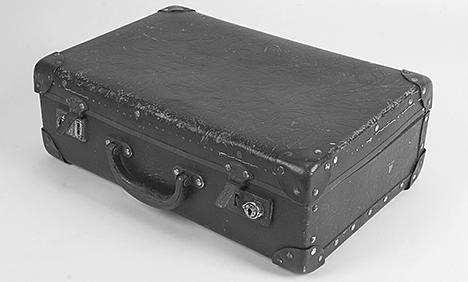
But: we can’t all make Aliyah. Many of us are here to stay and have zero plans to move anywhere else. What we perhaps need is a reminder of what it means to create a home in the diaspora. It sounds like a conflicting thought, I know. And yet, we have an obligation to protect our Jewish way of life no matter where we live.
“You can spend most of your day at work without your workplace becoming home,” Rabbi Lazer Gurkow wrote in his article Where are Jews truly at home? “You can also spend most of your life in
the diaspora without making it your home. If we are Jewish, then Israel is our home. We are in the Diaspora for a purpose—to help make these lands holier and more G dly places. But that is our job. It’s not our home.” (Chabad.org)
Perhaps our home is temporary. Can we still embrace it, knowing our real home is elsewhere? How do we live our Jewish life to the fullest in our current home, knowing it is transitional? Especially when so many Jewish communities around the world have disappeared from the map?
We have to make our Judaism mean something. We have to engage, celebrate, learn, study, interact, build and live with joy and purpose. We have to remember that with each act of service, each kind gesture, each mitzvah, each candle we light, we bring Jewish meaning into the world. It’s a tall order some days, and it’s okay to admit that. Much easier to focus on the negative. But we also know that ultimately, we have to move forward. Plus, Judaism has always provided us with a clear road map.
Here’s a question my husband often asks our children whenever they struggle: ‘Would you want to trade places with anyone else?’ Would we want to give up being Jewish just because it’s sometimes hard? I’m guessing most Jews would respond with a resounding ‘No.’ The joy, the warmth, the love will always outweigh the despair.
So no, we are not really at home here. But we do have a home in Israel, and we have a home in Judaism. Home is within us. We carry it with us wherever we go, and wherever we find ourselves. No matter who waves a protest sign in our temporary backyard.
Israeli mothers have had enough of the war. We are fed up with the endless violence, the mindless escalations, the aimlessness, the sacrificing of our children on the altar of political wins, the corruption and a prime minister who seems to care about nothing but his own political survival.
And the mothers are starting to rebel. Though we have not yet had a definable impact on the situation, and it is not clear if we ever will, we won’t stop speaking out for the Israel that we believe in.
All of my four adult children or their spouses have been called up for military service since Oct. 7, and one of my sons-in-law is still on active duty. Two of my daughters live in the south, one in the Israeli “envelope” that borders Gaza, and were displaced for months with their babies and lived with me while their husbands were away.
I have been volunteering in many activities, from collecting supplies for single mothers and displaced families to supporting the injured in rehab centers to transporting Palestinians from checkpoints throughout the country to hospitals in Israel through Road to Recovery. Although these experiences are nothing compared to what Gazan mothers are going through, this war is still a major disruption and a complete erasure of the possibility of normalcy.
Several women-led organizations have been created with variations on the theme of protecting our children: Mothers Against Violence, Mother Awake, Mothers on the Front, Mothers of Soldiers, Mothers Screaming, to name a few. I’m in most of these groups, and I regularly attend activities and protests. My living room is filled with handmade placards, and my WhatsApp is popping 24/7 with calls to stop the war, agree to a cease fire, release the hostages, let overstretched soldiers come home to their families and hold elections immediately.
Members of these mothers’ groups come from all sides of the political spectrum — including former right-wingers like me who have moved to the left and former Netanyahu voters who have told crowds that they feel betrayed. Yet most share the same vision: Violence only brings more violence, all human beings are human beings, and the only way to bring lasting peace and get the hostages back is
by speaking with our enemies instead of endlessly and mindlessly pounding away in Gaza while using our children as cannon fodder.
Over the past few weeks, the mothers’ groups have been exploding. The tipping point came with the impending invasion of Rafah. While pundits were describing an invasion as a booby trap that Hamas terrorists had been laying for months, while Palestinians were begging for basic humanitarian consideration, and while the American government was threatening Israel with ramifications, Prime Minister Benjamin Netanyahu was unfazed. He did whatever he wanted and invaded Rafah anyway. Which means, in a country with universal mandatory conscription from age 18, that our children did that work. And the bodies have continued to pile up, on all sides, with no deal anywhere on the horizon.
For many mothers, Rafah was the last straw. A group that is now called “Parents of Soldiers Screaming Enough!” (to include fathers, too) sent a letter with 900 signatures from combat parents calling for an end to the war. When that didn’t have any effect, we protested outside homes of cabinet ministers. When that also had no effect, the group began dressing up as injured soldiers and protesting outside hospitals.
Many Israelis suspect he is clinging to office to avoid facing trial on long-standing charges of corruption. Or that he is holding out for the U.S. presidential election and a president more indulgent of his hawkish vision for Israel.
Whatever the reason, while the Israeli government gripes about not having enough funds for displaced families from the Gaza envelope, it has had enough to spend on all-expense-paid missions

This is a big deal. The assumed silence and docility of soldiers’ parents has always been a sacred cow in Israel. Army service is treated as an honorable national duty, and parents are expected to suck it up and act as models of military obedience.
But no more. Because, as the group wrote in the letter, the war isn’t working, and the parents no longer trust the IDF and its political leadership to have the best interests of the country at heart. Certainly not of the soldiers.
And still, Netanyahu seems unmoved. Nothing touches him. Not dead hostages. Not dead soldiers. Not dead Gazans. Not threats of losing American aid. Not the rising tides of antisemitism on college campuses. Not the irreparable damage to American political culture. Not even threats of being arrested by the International Criminal Court. Nothing veers him from his path.
bringing right-wing influencers to Israel. Anyone with an audience willing to say that Israel is doing nothing wrong and that Palestinians are all antisemitic liars and that the “woke left” is the cause of everything wrong in the world may find themselves receiving a personal invitation from the Israeli government to spread their gospel.
As an American-Israeli, I think I have an additional unique perspective on all this. As a Barnard College alum who moved to Israel shortly after my 1991 graduation and marriage, I have been watching the campus protests closely. For a while I stopped writing and speaking critically of Israel out of fear of encouraging antisemitism. But then I realized that by self-silencing, I was exactly playing into Netanyahu’s hands. The chilling effect of the campus protests is precisely what he is aiming for. When American Jews are afraid, he is at his most powerful.
As awful as this is going to sound to my fellow Jews, I would like to say this: If we continue to respond to protests by insisting that it is all antiSee Israeli mothers are fed up page 9
Before I drove to meet a convicted antisemite, I carefully tucked my ancestral silver kiddush cup into my coat pocket. I needed him to see something Jewish and beautiful. Then I entered an uncertain and frightening space.
I am a volunteer with the Reconciliation Education and Counseling Crimes of Hate, a victim-centered restorative justice pilot program for offenders convicted of hate crimes. Known as REACCH, the program was established in 2022 by the office of Los Angeles County District Attorney George Gascón to give hate crime offenders the opportunity to atone.
Rather than serving a prison sentence, offenders instead enroll in probation and participate in one year of counseling, anti-bias education and victim reconciliation in a controlled setting. Towards the end of the program, the offender meets a “peer victim” — if not the direct victim of the crime, then someone from the same group — to address their own crimes and seek reconciliation. The theory is that offenders who are educated about the consequences of their hate crime will be less likely to commit another one.
I am the first Jewish person to participate as a REACCH peer victim. I have personally experienced antisemitism and as a Jew in America, I do not feel safe. I decided to volunteer for the program because I knew in my heart that some of the people who I think of as monsters must regret what they have done, and thought maybe it would heal me and heal them if we could meet.
I met Robert in a small private conference room in Los Angeles. (This is a pseudonym because I cannot share the offender’s real name.) Upon entering the room, he shook my hand and I quickly noted his reddened eyes and his distressed, clenched jaw. We sat down across a small, bare table. I reached into my coat pocket and carefully placed my grandmother’s kiddush cup in between us on the table. In such a sterile, confined space the cup brightened the room. I watched Robert look upon it with curiosity.
Robert began to share his story. Over the course of three hours in that room, I learned a valuable lesson: Some hate crime offenders indeed can feel remorse.
Robert was not the monster I expected to meet. He also was not born hating Jews.
I learned he experienced years of personal and professional hardships. Over time, these moments wrecked Robert’s selfesteem and mental health. Without having access to a peer network or a therapist, Robert bottled up his anger at the
world and began to see nuanced issues in black and white. Everything changed when Robert discovered antisemitic conspiracy theories on social media. Suddenly he could point to a singular source outside of himself for his problems, believing it was the Jews who were collectively responsible for his lifelong hardships. His destructive thoughts led him to commit a hate crime.
Though the antisemitic period in Robert’s life was short, it devastated my community. I remember when Robert’s hate crime shook me and my community. I was scared. Like previous antisemitic attacks that rattled my sense of safety, I worried that this was the spark that would light the powder keg of hate against me and my people.
After law enforcement arrested Robert, he sat inside a cell and took time to reflect. By understanding the gravity of his criminal sentence, he told me, he started to grasp the harm his crime had on the Jewish people.
this experience brought me a measure of calm and hope, because I saw that change was possible. My experience was not unusual: Research shows that programs like REACCH tend to have a positive psychological effect on victims.
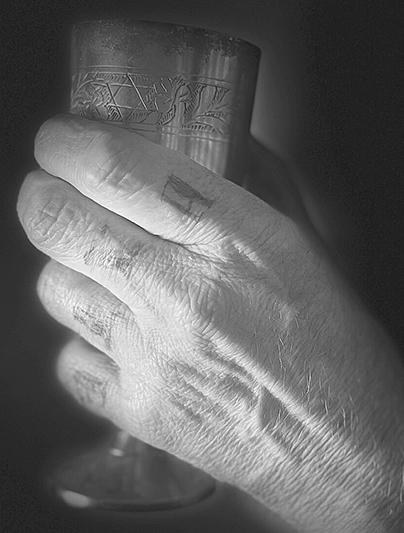
I stared at Robert sitting across from me and wondered whether I should be scared or angry. I couldn’t help but feel sadness for my Jewish community and even some sympathy for him.
Robert started crying. His eyes were red from tears. He confessed he learned something quite sobering during his therapy sessions: He could never take away the pain and anxiety he had caused to the victims of his crime — no matter how much good he did for the rest of his life. But he came to realize that he could make a change in himself and that he could start affecting the world in a positive way.
It brought me a measure of relief and hope to see him seek forgiveness from me, but it was also troubling for me as a Jew to watch him hold so much self-hatred over his own actions.
In the end, I told Robert that it was okay to forgive himself. I was absolutely certain that he was remorseful and understood the impact of his crimes. I also knew that if Robert held onto his self-hatred, it would not right the wrongs of this broken world.
The REACCH program helped me recognize that hate crime offenders are humans and can have the capacity to feel remorse and seek atonement. Although it was easier to imagine every antisemite as a cold-hearted monster out to target me,
The experience also led me to wonder how many other hate crime offenders are decaying in prison for decades and may likewise feel remorse. According to the FBI’s latest figures, law enforcement agencies reported over 11,000 hate crimes incidents in 2022 alone. I choose to believe there must be countless numbers of offenders who are sitting in prison today wishing they had a chance to apologize and work with a therapist to uncover the roots of why they took up hate. Unfortunately today there are too few opportunities for these offenders. Nor is there this opportunity for the victimized community to do much with their pain.
Instead, the typical approach to prosecuting hate crimes may actually make communities less safe. Today, convicted hate crime offenders who are sentenced to prison are likely to be surrounded by white nationalists who have the capacity to indoctrinate newcomers into violent gangs. For the offenders who regret their crimes or could be helped to, how are these conditions possibly helping them rehabilitate?
At the moment, REACCH is a small pilot program in need of permanent funding, and so I challenge all of us to think big for a moment: By investing into models like REACCH, what could the future look like?
I wager that in a few months Robert will be speaking to audiences about the dangers of antisemitic conspiracy theories.
After looking him in the eye and seeing the burning desire he had to correct his wrongs, I feel confident that Robert will turn from being an enemy of my people into one of our greatest allies. At a time when our safety feels especially tenuous, this vision for the future gives me hope.
James Finney-Conlon is a public policy professional in Los Angeles.
The views and opinions expressed in this article are those of the author and do not necessarily reflect the views of JTA or its parent company, 70 Faces Media.
Dreading wedding season? Shut up and dance with me.
In Jami Attenberg’s 2013 novel The Middlesteins, there’s a chapter about a joint bar and bat mitzvah told entirely from the perspective of the parents’ friends. So indistinguishable are these Cohns, Grodsteins, Weinmans and Frankens that the chapter is narrated in the first-person plural.
“We were at the age where we had almost been forgotten but were not quite old enough to be heralded for still being alive after all these years,” they explain. “Of course we were seated together at the reception, the eight of us.”
When I first read The Middlesteins, I was close to the age of the parents, and I thought it was the most depressing description of the disappearing act of encroaching age that I had ever read. And it only gets worse. During the reception, the couples limit themselves to one quick dance. Otherwise, [w]e checked our watches, and thought about the errands we needed to run the next day, the walk we would take in the sunshine, the phone calls we would make to our children, some of whom lived in other states, with grandchildren we missed terribly. We had only been there for two hours, but it was already starting to feel late. I’d like to say that after reading the book I vowed never to become “those people.” Or that I promised myself I’d be, if not the “bride at every wedding” (as Eleanor Roosevelt once described her narcissistic uncle Teddy), then the kind of guest my hosts wouldn’t regret inviting.
Instead, for perhaps a decade I was exactly those people. I treated weddings and b’nai mitzvah as chores. I complained that the music was too loud. I spent way too much time in the hallways. I calculated how soon I could leave without seeming rude. And then, over the past two years, more and more of my friends’ kids started marrying, and I decided I wasn’t ready to fade into the not-so-good night of the “parents’ friends table.” At the next wedding, instead of trying to make myself heard over the din of Mr. Brightside, I pulled my wife onto the dance floor. And stayed there. I have maybe three moves, and I used them all, again and again. This time I did make a vow: that I’d stay on my two left feet until the band packed up their instruments. I’ve stuck with it. You might credit my transformation to the pandemic, and probably should. After two-plus years in lockdown, I joined
others in “letting life out of the box,” as the poet Tony Hoagland puts it.
I also had Jewish guilt — even law! — as a goad. The Talmud, in Brachot 6b, says rejoicing with the bride and groom — simchat chatan v’kallah – is a mitzvah, meaning a commandment, and no mere good deed.
And 2,000 years ago the rabbis anticipated the self-consciousness of graceless middle-aged men. If you are worried about
 Credit: Andreas Douvitsas/Getty Images
Credit: Andreas Douvitsas/Getty Images
making a fool of yourself on the dance floor, remember the story of the great scholar Rabbi Shmuel son of Rabbi Isaac, who would juggle myrtle twigs before the bride (Ketubot 17a). When Shmuel’s colleague Rabbi Zeira said such antics were beneath him, Shmuel squirted him with a seltzer bottle. (Okay, not really, but the same passage goes on immediately to explain that not only did Shmuel not demean himself or Torah, but that when he died he was blessed with an extremely rare sendoff of divine fire.)
And ultimately, I have Jewish history as inspiration. In her classic guide, The Jewish Wedding, Anita Diamant quotes a saying she attributes to Holocaust survivors: “To dance at a Jewish wedding is to dance on Hitler’s grave.” She continues: “For every generation, weddings are a glimpse into the future, a repudiation of past griefs, and a celebration of the here and now.”
I’ve also learned a secret over these past few years. As dumb as you might feel clomping around in a circle while holding hands with a sweaty neighbor (Jews call this “dancing”), others find it admirable. I’ve had a few people, including brides
and grooms, come up to us at the end of weddings and compliment us for having closed down the dance floor. I mean no disrespect to people who either can’t or don’t wanna dance with somebody, shake it off, shut up and dance or celebrate good times, come on. Your hosts really don’t mind. And I’ll tell you how I know this: Recently we celebrated the wedding of my middle child to a brilliant, kind and beautiful woman whose smile is as radiant as his. The music was loud.
The dance floor was packed. I was where I needed to be. And my pounding heart grew big enough to cherish everyone in the room, whether they were getting down or sitting it out. Because when it comes to celebrating a young couple’s love amid a cloudy here and now, I’m Mr. Brightside.
Andrew Silow-Carroll is editor at large of the New York Jewish Week and managing editor for Ideas for the Jewish Telegraphic Agency.
The views and opinions expressed in this article are those of the author and do not necessarily reflect the views of JTA or its parent company, 70 Faces Media.
Continued from page 8
semitism and that Israel is doing nothing other than acting in self-defense, we will be taking an active part in bringing on not only more death on all sides, but also in ushering in a despotic future for Israel and parts of the rest of the world. The threats to democracy here and abroad are real. And that will be unhealthy for Jews and other living things. Instead of supporting Bibi, we need to be supporting the mothers — calling for a deal to end the war and release the hostages, and demanding new elections in Israel. That’s the best thing for the future of Israel, and for everyone else.
Elana Sztokman is an award-winning Jewish feminist author, anthropologist and educator. Follow her on Substack at The Roar.
The views and opinions expressed in this article are those of the author and do not necessarily reflect the views of JTA or its parent company, 70 Faces Media.
B’NAI ISRAEL SYNAGOGUE
618 Mynster Street Council Bluffs, IA 51503-0766
712.322.4705 www.cblhs.org
BETH EL SYNAGOGUE
Member of United Synagogues of Conservative Judaism 14506 California Street Omaha, NE 68154-1980
402.492.8550 bethel-omaha.org
BETH ISRAEL
SYNAGOGUE
Member of Union of Orthodox Jewish Congregations of America 12604 Pacific Street Omaha, NE. 68154
402.556.6288 BethIsrael@OrthodoxOmaha.org
CHABAD HOUSE
An Affiliate of Chabad-Lubavitch 1866 South 120 Street Omaha, NE 68144-1646
402.330.1800 OChabad.com email: chabad@aol.com
LINCOLN JEWISH COMMUNITY:
B’NAI JESHURUN
South Street Temple
Union for Reform Judaism 2061 South 20th Street Lincoln, NE 68502-2797
402.435.8004 www.southstreettemple.org
OFFUTT AIR
FORCE BASE
Capehart Chapel 2500 Capehart Road Offutt AFB, NE 68123
402.294.6244 email: oafbjsll@icloud.com
TEMPLE ISRAEL
Union for Reform Judaism (URJ) 13111 Sterling Ridge Drive Omaha, NE 68144-1206
402.556.6536 templeisraelomaha.com
LINCOLN JEWISH COMMUNITY:
TIFERETH ISRAEL
Member of United Synagogue of Conservative Judaism 3219 Sheridan Boulevard Lincoln, NE 68502-5236 402.423.8569 tiferethisraellincoln.org
Monthly Speaker Series Service, Friday, June 14, 7:30 p.m. with our Bob Yaffe, he will discuss his book Relinquished. Our service leader is Larry Blass. Everyone is always welcome at B’nai Israel! For information about our historic synagogue, please visit our website at www.cblhs.org or contact any of our other board members: Renee Corcoran, Scott Friedman, Rick Katelman, Janie Kulakofsky, Howard Kutler, Carole and Wayne Lainof, Ann Moshman, MaryBeth Muskin, Debbie Salomon and Sissy Silber. Handicap Accessible.
Services conducted by Rabbi Steven Abraham and Hazzan Michael Krausman.
IN-PERSON AND ZOOM MINYAN SCHEDULE: Mornings on Sundays, 9 a.m.; Mondays and Thursdays, 7 a.m.; Evenings on Sunday-Thursday, 5:30 p.m.
FRIDAY: Kabbalat Shabbat 6 p.m. at Beth El & Live Stream.
SATURDAY: Shabbat Morning Service, 10 a.m. at Beth El & Live Stream followed by Kiddush Lunch in honor of Joan Latchaw’s 80th Birthday; Havdalah, 9:45 p.m. Zoom only.
SUNDAY: Morning Minyan, 9 a.m. Zoom Only.
MONDAY: Monday Mahj Madness, 3 p.m.
FRIDAY-June 21: Kabbalat Shabbat 6 p.m. at Beth El & Live Stream.
SATURDAY-June 22: Shabbat Morning Service, 10 a.m. at Beth El & Live Stream; Havdalah 9:45 p.m. Zoom only.
Please visit bethel-omaha.org for additional information and service links.
FRIDAY: Nach Yomi, 6:45 a.m.; Shacharit, 7 a.m.; Mincha/Kabbalat Shabbat, 7 p.m.; Candlelighting, 8:41 p.m.
SATURDAY: Shabbat Kollel, 8:30 a.m.; Shacharit, 9 a.m.; Tot Shabbat 10:30 a.m.; Youth Class 10:45 a.m.; Tehillim, 7:15 p.m. at the Ziv’s; Soulful Torah, 7:45 p.m. with Rabbi Geiger; Mincha 8:30 p.m.; Laws of Shabbos/Kids Activity 9 p.m.; Havdalah, 9:51 p.m.
SUNDAY: Shacharit, 9 a.m.; Kinyan, 9:40 a.m.; Mincha/Ma’ariv 8:30 p.m.
MONDAY: Nach Yomi, 6:45 a.m.; Shacharit, 7 a.m.; Mincha/Ma’ariv, 8:30 p.m.
TUESDAY: Nach Yomi, 6:45 a.m.; Shacharit, 7 a.m.; Kinyan, 8 p.m.; Mincha/Ma’ariv, 8:30 p.m.
WEDNESDAY: Nach Yomi, 6:45 a.m.; Shacharit, 7 a.m.; Mincha/Ma’ariv, 8:30 p.m.
THURSDAY: Nach Yomi, 6:45 a.m.; Shacharit, 7 a.m.; Kinyan, 8 p.m.; Mincha/Ma’ariv, 8:30 p.m.; Parsha Class, 9:10 p.m.
FRIDAY-June 21: Nach Yomi, 6:45 a.m.; Shacharit, 7 a.m.; Mincha/Kabbalat Shabbat, 7 p.m.; Candle-
lighting, 8:43 p.m.
SATURDAY-June 22: Shabbat Kollel, 8:30 a.m.; Shacharit, 9 a.m.; Tot Shabbat, 10:30 a.m.; Youth Class 10:45 a.m.; Tehillim, 7:15 p.m. at the Ziv’s; Soulful Torah, 7:45 p.m. with Rabbi Geiger; Mincha, 8:30 p.m.; Laws of Shabbos/Kids Activity 9 p.m.; Havdalah, 9:53 p.m.
Please visit orthodoxomaha.org for additional information and Zoom service links.
All services are in-person. All classes are being offered in-person and via Zoom (ochabad.com/academy). For more information or to request help, please visit www.ochabad.com or call the office at 402.330.1800.
FRIDAY: Shacharit, 8 a.m.; Inspirational Lechayim, 5:45 p.m. with Rabbi and friends: Ochabad.com/ Lechayim; Candlelighting, 8:41 p.m.
SATURDAY: Shacharit, 9:30 a.m. followed by Kiddush and Cholent; Shabbat Ends, 9:50 p.m.
SUNDAY: Sunday Morning Wraps: Shacharit, 99:30 a.m., Video Presentation, 9:30 a.m. and Breakfast, 9:45 a.m.; Torah and Tea, 10:30-11:15 a.m.
MONDAY: Shacharit, 8 a.m.; Personal Parsha, 9:30 a.m.; Intermediate Biblical Hebrew Grammar, 10:30 a.m. with Prof. David Cohen; Parsha Reading, 6 p.m. with Prof. David Cohen.
TUESDAY: Shacharit 8 a.m.; Intermediate Biblical Hebrew Grammar, 6 p.m. with Prof. David Cohen; Introductory Biblical Hebrew Grammar, 7 p.m. with Prof. David Cohen.
WEDNESDAY: Shacharit, 8 a.m.; Mystical Thinking (Tanya), 9:30 a.m.; Introductory Biblical Hebrew Grammar, 10:30 a.m. with Prof. David Cohen; Parsha Reading, 11:30 a.m. with Prof. David Cohen.
THURSDAY: Shacharit 8 a.m.; Introduction to Aleph-beth, Vowels & Reading Hebrew, 10 a.m. with Prof. David Cohen; Advanced Biblical Hebrew Grammar, 11 a.m. with Prof. David Cohen; Talmud Study (Sanhedrin 34), noon; Introduction to Alphabet, Vowels & Reading Hebrew, 6 p.m. with Prof. David Cohen; Kitzur Shulchan Aruch (Code of Jewish Law) Class, 7 p.m.
FRIDAY-June 21: Shacharit 8 a.m.; Inspirational Lechayim, 5:45 p.m. with Rabbi and friends: Ochaba d.com/Lechayim; Candlelighting, 8:43 p.m.
SATURDAY-June 22: Shacharit 9:30 a.m. followed by Kiddush and Cholent; Shabbat Ends, 9:52 p.m.
Services facilitated by Rabbi Alex Felch. All services offered in-person with live-stream or teleconferencing options.
FRIDAY: Erev Shabbat Service with Rabbi Alex, 6:30-7:30 p.m. at SST; Shabbat Candlelighting, 8:41
p.m.
SATURDAY: Shabbat Morning Service, 9:30-11 a.m. at TI; Torah Study, noon on Parashat Naso via Zoom; Potluck Dinner and Family Game Night, 6 p.m. at SST. Adults and kids of all ages are welcome. Please bring a dish to share; Havdalah, 9:51 p.m.
SUNDAY: Men’s Bike/Coffee Group, 10:30 a.m. at The Mill on the Innovation Campus. For more information or questions please email Al Weiss at albertw801@gmail.com; Jewish Book Club, 1:30 p.m. on Zoom and will discuss The Amen Effect: Ancient Wisdom to Mend Our Broken Hearts and World by Sharon Boris. For more information, please contact Deborah Swearingen at: devra60@ gmail.com; Pickleball, 3-5 p.m. Anyone interested in playing or learning how to play can text Miriam at 402.470.2393. If there are enough interested people; we will play in the Social Hall at TI.
FRIDAY-June 21: Erev Shabbat Service with Rabbi Alex, 6:30-7:30 p.m. at SST; Shabbat Candlelighting, 8:43 p.m.
SATURDAY-June 22: Shabbat Morning Service, 9:30-11 a.m. at TI; Torah Study noon on Parashat Behaalotecha via Zoom; Havdalah, 9:53 p.m.
FRIDAYS: Virtual Shabbat Service, 7:30 p.m. every first and third of the month at Capehart Chapel. Contact TSgt Jason Rife at OAFBJSLL@icloud.com for more information.
In-person and virtual services conducted by Rabbi Benjamin Sharff, Rabbi Deana Sussman Berezin, and Cantor Joanna Alexander
FRIDAY: Drop in Mah Jongg, 9-11 a.m. In-Person; Shabbat Shira Service, 6 p.m. In-Person & Zoom
SATURDAY: Torah Study, 9:15 a.m. In-Person & Zoom; Shabbat Morning Service, 10:30 a.m. In-Person & Zoom.
WEDNESDAY: Yarn It, 9 a.m.; Exploring the Holocaust: Perspectives of Persecution, 7 p.m. In-Person.
FRIDAY-June 21: Drop in Mah Jongg, 9-11 a.m. InPerson; Shabbat B’yachad Service, 6 p.m. In-Person & Zoom.
SATURDAY-June 22: Torah Study, 9:15 a.m. In-Person & Zoom; Shabbat Morning Service, 10:30 a.m. InPerson & Zoom. Please visit templeisraelomaha.com for additional information and Zoom service links.
The Jewish Press will be closed on Thursday, July 4 for Independence Day. The deadline for the July 12 issue is Tuesday, July 2, 9 a.m. There will be no Jewish Press on July 5, 2024. Questions? Call 402.334.6448.
LEO NASATIR
This article was produced as part of JTA’s Teen Journalism Fellowship.
If anyone had asked Chloe Hockfield last Oct. 6 whose name she would check off on her first presidential ballot, she would have answered firmly.
Now, as the United States inches closer to the November 2024 election, she is not so certain. The catalyst: a war taking place thousands of miles away from her Pennsylvania home to which she feels such a connection that it may just tip her ballot.
“Altogether, I feel like Trump is not a good person and should not be president, even though I support his stance on Israel and the war,” said Hockfield. “I was planning on voting for [Biden] before the war, and it definitely changed how strongly I feel about him. Before I guess I was 100% Biden, but I definitely did question — ‘should I be voting for Trump to support the Jewish people?’”
When Hamas launched its deadly attack on southern Israel on Oct. 7, it focused attention on young people’s place in the shaping and outcome of the presidential race. With the 2024 election once again expected to be razor-thin, the votes of young people are becoming increasingly coveted by campaigns up and down the ballot.
President Joseph Biden is seen to be underperforming among young voters, especially over his
support for Israel in its war on Gaza. In NPR/PBS NewsHour/Marist survey taken May 21-23, voters 18-29 were the most likely of any age group to say the U.S should increase humanitarian aid to Palestinians and should cut off all support for Israel until there is a ceasefire.
Meanwhile, some Jewish teens are leaning in the exact opposite direction. Despite Biden’s consistent support for Israel in the form of military aid, even some liberal-leaning Jewish teens have begun to question their loyalty towards him due to this issue, including Hockfield. Biden’s threat to halt some shipments of American weapons to Israel, when coupled with Trump’s support for Israel — his administration moved the U.S. embassy to Jerusalem and brokered the Abraham Accords between Israel and former Arab antagonists — has led some Jewish teens to question the typical liberal leanings of their demographic.
“I’m still debating which side to choose,” says Noya Chirashnya, a first-time, 18-year old Jewish voter from California, “primarily because Trump was really good when he was in office about his relations with Israel. That’s why I’ve been going back and forth because, on one hand, domestically, Trump wasn’t the best. But, when it came to Israel, he was really strong, and I think at the moment that is more needed.”
Jewish teens’ lack of political certainty following Oct. 7 is not exclusive to the presidential race.
Alex Cohen, an 18-year-old Jew from St. Louis, Missouri, is represented by Rep. Cori Bush, a member of the House’s progressive “Squad.” In November, some 30 St. Louis Jewish leaders criticized Bush in an open letter for her comments on X (formerly Twitter) referring to Israel’s “ethnic cleansing” of Palestinians. The letter described such remarks as antisemitic targeting of Israel.
For Cohen, seeing her local Jewish community come together against the incumbent provoked her to stay away from supporting Bush despite the teen’s Democratic leanings in a conservative state.
“[Bush] was always a little far left for me,” Cohen said, “but especially since she’s been extremely outspoken and anti-Israel and even what some people would describe her pro-Hamas, I definitely will not be voting for her. She’s being primaried by Wesley Bell, and he’s being supported by a lot of Jewish activists.”
Young Jews, like many young voters, often do not list Israel as a top priority come November. According to a recent Harvard Youth Poll, Americans between the ages of 18 and 29 listed inflation, health care and housing as their top priorities; the IsraeliPalestinian issue ranked 15th out of 16 issues.
Read more at www.omahajewishpress.com.
NORMAN HIRSH DENENBERG
Norman Denenberg passed away on June 6, 2024, at age 98 in his home surrounded by loving friends and family. Services were held on June 7, 2024, at Beth El Synagogue and he was buried at Beth El Cemetery.
He was preceded in death by his wife of 67 years, Eunice Denenberg.
He is survived by one of his seven siblings, Michael Denenberg; his children: Larry Denenberg (Rachel Rosner), Steven Denen-
berg (Tiffany) and Debbie Denenberg; and grandchildren: Rebecca, Lev, Daniel, Michael, Ayla, Sasha, Eli, Sima and Solomon. Norman was a WWII veteran, a Navy officer who flew for the Navy Air Corps. He was a Deputy County Attorney and then practiced law privately where he looked out for the poor and the underdog. He died on D Day, and his funeral was on Rosh Chodesh.
Memorials to Beth El Synagogue, Beth Israel Synagogue or Chabad of Nebraska.
RON KAMPEAS
Israeli forces rescued four hostages held since Oct. 7 in the central Gaza Strip, including Noa Argamani, the festival-goer who was filmed screaming as she was carried away by terrorists on a motorcycle.
In addition to Argamani, 26, the army said in a statement that Almog Meir Jan, 22; Andrey Kozlov, 27; and Shlomi Ziv, 41, were rescued Saturday in the raid. All four were attending the Nova music festival on Oct. 7, when Hamas terrorists killed approximately 1,200 people and abducted some 250, launching the war.
The army said special forces carried out the operation in Nuseirat in the center of the coastal territory. Arnon Zamora, a commander of the operation, was killed in the battle.
mani was reportedly able to see her mother on Saturday June 8; the father of another rescued hostage, Jan, was found dead that same day, the victim, his sister said, of a broken heart.
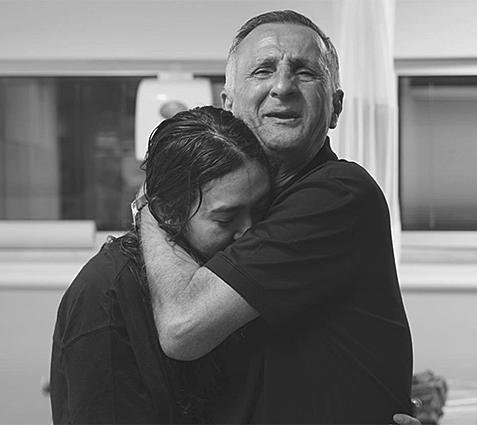
Hamas initially said “dozens” of Palestinians were killed in the operation. Media later quoted the Hamas-run Gaza health ministry as saying the number was more than 200. It did not report what proportion were civilians and what proportion were combatants.
A Hamas spokesman later said that Israeli captives were among the dead, but did not offer any evidence. The spokesman, posting on Telegram, said the attack would “pose a great danger” to the remaining captives. About 120 people are thought to remain captive, including dozens who have been killed.
Argamani in particular became a symbol of Oct. 7, and especially of the massacre at the Nova festival where terrorists killed 364 people, after footage of her abduction emerged that day. The fate of her boyfriend, Avinatan Or, also seen in the video being led away by terrorists, is not known.
Photos of Argamani enjoying herself before her abduction featured prominently on posters, fliers and social media advocating for the release of the hostages, and Hamas released at least two videos of her in captivity since Oct. 7. Her plight gained additional note as her mother Liora, who has terminal brain cancer, pled for her release. Arga-


Before someone offers you alcohol or other drugs, decide what you are going to say.
Having the facts can give you confidence. For more information, call

Israeli forces have now rescued a total of seven hostages from Gaza in three separate operations. More than 100 others were freed as part of a ceasefire deal in November. Israeli forces have mistakenly killed three hostages, and others are known to have been killed since Oct. 7. Israel has recovered a number of bodies of hostages who have died.
Israeli Prime Minister Benjamin Netanyahu spoke with the released hostages. Images of the hostages reuniting with family proliferated on Israeli media.
In a statement, Netanyahu congratulated the commanders of the operation. “The entire nation salutes you and the courageous fighters who today risked their lives in order to save lives,” he said. “Yet again you have proven that Israel does not surrender to terrorism and acts with boundless valor and resourcefulness to return home our hostages.”
The Biden administration also praised the action. “We commend the work of the Israeli security services that conducted this daring operation,” Jake Sullivan, the national security adviser, said in a statement.
The operation came as Hamas is weighing a ceasefire proposal from Israel and the United States that would see more hostages go free. Netanyahu has faced pressure from protesters to reach a deal, though his allies on the far right oppose the one that is on the table.
The release also came just hours before former Defense Minister Benny Gantz, a member of the war cabinet and rival to Netanyahu, was set to address the nation in what Israeli media said was likely to be his announcement that he was pulling out of the government, in part because Netanyahu has failed to end the war and release the hostages.
Gantz instead canceled the planned press conference.



CLASSIFIED ADVERTISING in over 150 newspapers. Reach thousands of readers for $225/25 word ad. Contact the Jewish Press or call 1-800-369-2850.
HELLO NEBRASKA! Introducing www.nepublicnotices.com, a new public notice website presented as a public service by all Nebraska newspapers. Free access, fully searchable – because democracy depends upon open government and your right to know.
AFFORDABLE PRESS Release service. Send your message to 155 newspapers across Nebraska for one low price! Call 1-800369-2850 or www.nebpress.com for more details.
DENTAL INSURANCE from Physicians Mutual Insurance Company. Coverage for 350 plus procedures. Real dental insuranceNOT just a discount plan. Do not wait! Call now! Get your FREE Dental Information Kit with all the details! 1-855-490-4149. www.dental50plus.com/81 #6258
PORTABLE OXYGEN Concentrator? May be covered by Medicare! Reclaim independence and mobility with the compact design and long-lasting battery of Inogen One. Free information kit! Call 855-385-3580.
GUN SHOW: June 21-23, 2024, Westfair Council Bluffs, IA Fri 49pm, Sat. 9am-5pm, Sun. 9am-3pm. $10 (under 14 FREE) . More info: 563-608-4401. www.marvkrauspromotions.net
DOES YOUR basement or crawl space need some attention? Call Thrasher Foundation Repair! A permanent solution for waterproofing, failing foundations, sinking concrete and nasty crawl spaces. FREE Inspection & Same Day Estimate. $250 off ANY project with code GET250. Call 1-844-958-3431.
WHEN VETERINARY care is unavailable or unaffordable, ask for Happy Jack® animal healthcare products for cats, dogs, & horses. At Tractor Supply®. (www.happyjackinc.com).
BECOME A Published
On June 13, 1944, Anne Frank wrote these lines in her diary:
“It’s not just my imagination — looking at the sky, the clouds, the moon and the stars really does make me feel calm and hopeful... Nature makes me feel humble and ready to face every blow with courage!”
She was looking at a chestnut tree, growing just outside her window. Anne’s tree thrived in Amsterdam until 2009, ultimately succumbing to disease and a windstorm in 2010. Through the efforts of the Anne Frank House, saplings grown from the original tree now flourish across the globe, forming a living memorial to the memory of Anne Frank. Bob Hawkins and the team at the Vallonia Tree Seedling Nursery in Vallonia, Indiana, hapve kept the tree’s descendants alive for 15 years and counting.
On Friday, April 26, one of those descendents was introduced to the Omaha landscape, in the garden of the College of St. Mary. Technically, as there was a big storm on the way, it wasn’t planted right then and there, but the ceremony was conducted nonetheless.
Lauren Bairnsfather, Chief Executive Officer of the Anne Frank Center USA, told the crowd:
“This tree was awarded by the Anne Frank Center USA in recognition of the College of Saint Mary’s commitment to education and sharing Anne Frank’s message of hope.
“Anne Frank was born on June 12, 1929, in Frankfurt, Germany. Her family fled Germany in the first year of Nazi rule, 1933, for the Netherlands, a country they believed would be safe. But in 1942, the Frank family and 4 others were forced into hiding in Amsterdam. Anne, her sister Margot and parents Edith and Otto, along with the Van Pels family – Auguste, Hermann and Peter, and Fritz Pfeffer, spent over two years hiding in an annex of rooms in Amsterdam. After being betrayed
to the Nazis, Anne, her family, and the others in hiding with them, were captured and deported to the Dutch transit camp Westerbork, and then to Auschwitz. In March of 1945, seven months after she was arrested, and mere months before liberation, Anne Frank died of typhus at the Bergen-Belsen concentration camp in Germany. Otto Frank was the sole survivor.”
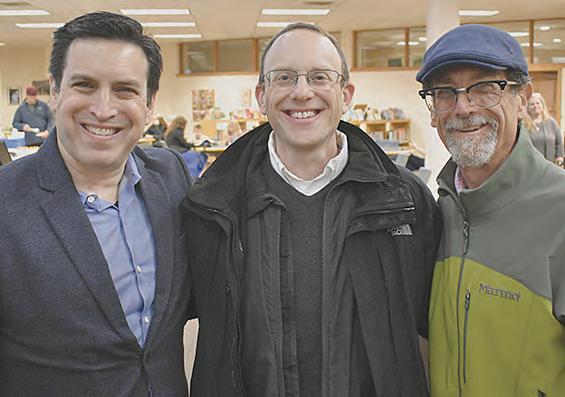
Temple Israel’s Head Rabbi Ben Sharff addressed the crowd, as did CSM President Heather Smith:
“We are deeply honored to have been chosen as a recipient of a sapling grown from Anne Frank’s cherished chestnut,” she said. “It is a privilege to be entrusted with this living memorial, and we eagerly anticipate its profound impact as a symbol of resilience, hope and remembrance.”
With each sapling planted, the center shares Anne Frank’s love of nature with organizations across its coalition that are committed to honoring Anne Frank’s memory through education, free expression and belief in humanity.
Dr. Mark Gudgel, assistant professor of education, spear-
headed CSM’s effort to be considered a site for one of the saplings. He said it is fitting that an institution dedicated to the education of young women should be the home of this tribute to the Holocaust.
“The mission of our university is deeply rooted in the values of the Sisters of Mercy and both align brilliantly with Anne Frank’s legacy and the incredible work that she has inspired throughout the world,” said Gudgel, who teaches a course on the Holocaust in film and literature.
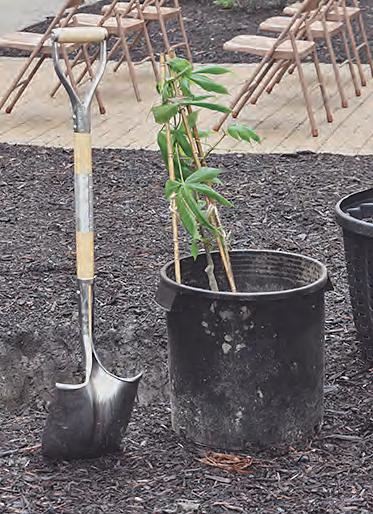
“The College of Saint Mary is deeply honored; we are dedicated to being excellent stewards of the tree as it grows, eager to receive visitors, and committed to furthering the legacy of Anne Frank by continuing to provide young women with an education that will help them to become leaders in this world.”
In a 1968 speech, Anne Frank’s father, Otto Frank, reflected the impact of the chestnut tree on his youngest daughter. “How could I have known,” he asked, “how much it meant to Anne to see a patch of blue sky, to observe the seagulls as they flew, and how important the chestnut tree was for her, when I think that she never showed any interest in nature.” “Still,” he acknowledged, “she longed for it when she felt like a bird in a cage.”



